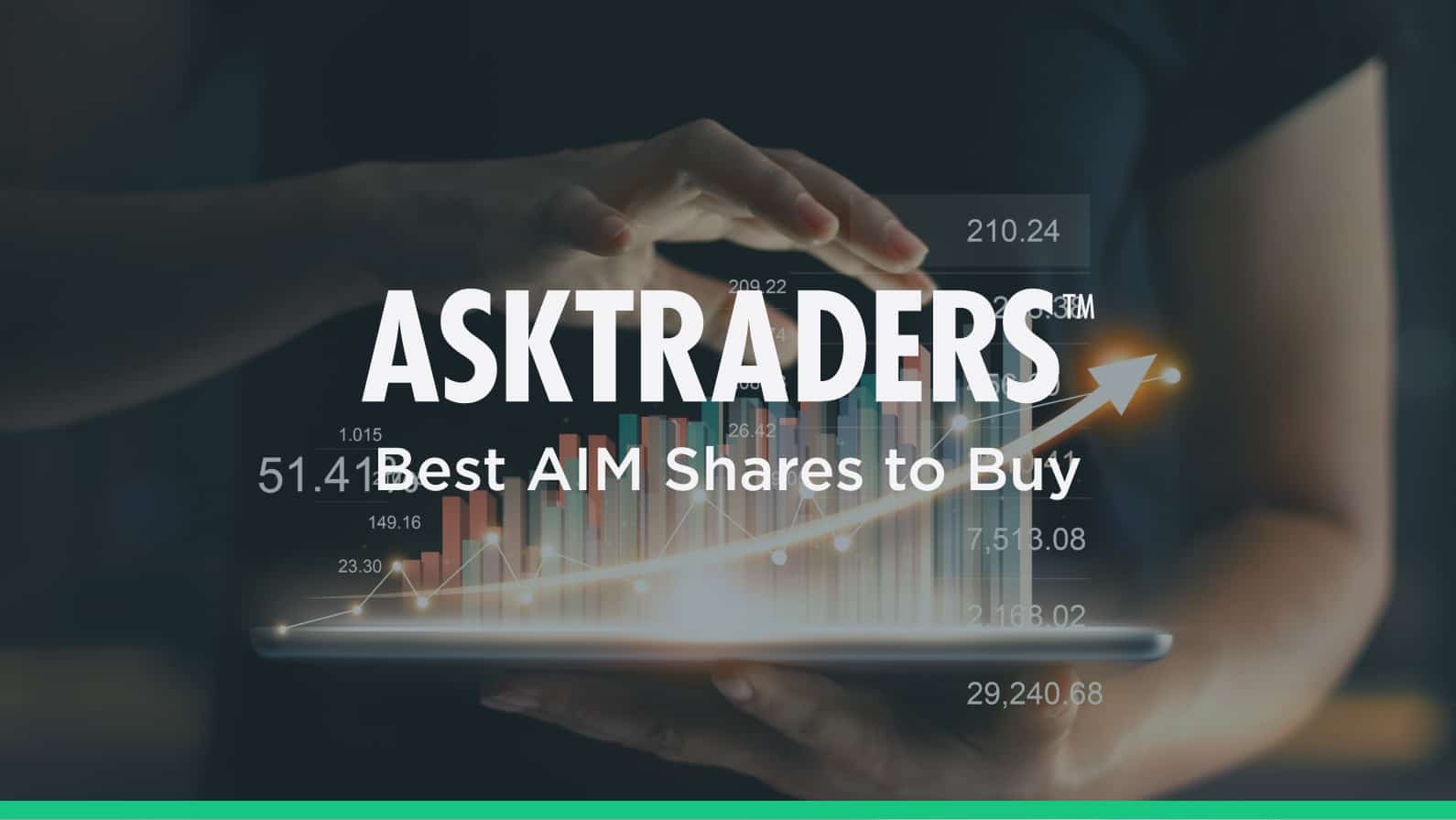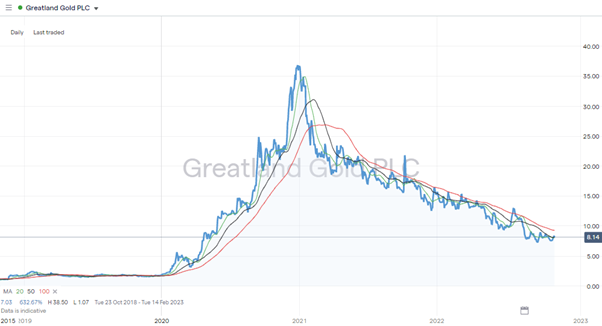AIM stocks are high risk, high reward, and in this guide, we’ll explore everything you need to know about them. This includes how to trade them as safely as possible, and what you need to do to optimise returns.
Using technical and fundamental analysis, we’ll establish which are the best AIM shares on the market at the moment. Due to the risk profile of the sector, few experienced investors would suggest allocating too large a percentage of capital to AIM shares. However, there is room for them as part of a well-diversified portfolio, and if you make the right stock pick, they can boost overall returns.

The Best AIM Shares to Buy
The varied range of stocks in the AIM market is part of its appeal. There are household names such as YouGov and Fevertree Drinks PLC available to trade.
The largest company on the AIM is Greencoat Renewables, which might not be as instantly recognisable but has grown to have a market capitalisation of £1.15bn. This firm offers an indication of how AIM stocks can post rapid increases in value and provides its shareholders with a way to tap into the booming green energy market.
With the above in mind, which AIM stocks are the best investment opportunities right now?
AB Dynamics (LON: ABDP)
AB Dynamics (LON: ABDP) is a supplier of automotive test systems to both UK and overseas car producers. The company was initially founded in 1982 as a vehicle engineering consultancy, but has continued to grow steadily over the years and now has a market capitalisation of £363m.
AB Dynamics has two main segments to its business: track testing and laboratory simulation testing. In recent years, the firm’s track-testing segment, which is its primary revenue driver, has grown significantly in the US. It also saw further development in the simulation sector.
The fundamentals of the company are strong due to self-driving technology being a growth sector. Investor optimism about future revenue streams from that business line means that the current P/E ratio of the stock is a relatively high 30. While this makes the firm far from cheap, there are technical indicators that point towards the recent upward price move gaining momentum.
YOUR CAPITAL IS AT RISK
Boohoo Group PLC (LON: BOO)
Online fashion retailer Boohoo Group (LON: BOO) has been something of a roller-coaster ride for investors and highlights the extreme price volatility that can be expected from stocks in the AIM market. Between March and June 2020, the BOO share price more than doubled in value when it surged by more than 162%. Then, after recording that all time high, BOO stock has subsequently fallen in value by as much as 90.21%.
Now trading back at lower price levels, Boohoo provides a perfect example of the need to dedicate time and research when investing in AIM stocks. In Boohoo’s case, it’s a matter of balancing negative press reports regarding business practices against the fact that the firm’s business model has a proven track record in terms of revenue streams.
A lot of the selling pressure can be attributed to two factors. One is the number of investors who were attracted to the high-profile nature of Boohoo and who were easily shaken out of positions. The second relates to concerns about the firm’s accounting practices, which resulted in ‘Big 4’ auditor PwC severing ties with the company in October 2020.
With a reorganisation of its governance and operational structures well underway, there is an opportunity for Boohoo management to focus on what they do well. The online clothes sector boomed during the COVID-19 lockdowns, and while a return to normality will impact sales, a seismic shift in consumer habits was initiated and remains engrained.
Boohoo remains one of the highest-profile AIM stocks to watch, but one potential risk factor to look out for is the threat of an online sales tax. High street retailers have called for a level playing field, and this is something that could disrupt Boohoo’s business.
YOUR CAPITAL IS AT RISK
Asos (LON: ASC)
The UK-based online retailer has gained significant popularity for its wide range of clothing, footwear, accessories, and beauty products targeted at young adults.
Founded in 2000, the firm is now one of the most high profile stocks on the AIM market, and has customers in markets reaching around the globe. UK, Europe, the US, and Australia are all big markets for ASOS. The company has had a few peaks over the past 10 years, and the Covid acceleration of online retail was a huge boon for Asos. Since then, the stock price has retreated, but with this comes opportunity.
ASOS has been investing in technology, expanding its product range, and improving its logistics capabilities to better compete in the crowded online fashion space. The fast fashion industry is notorious for thin margins, and ASOS has had to navigate rising costs, including warehousing, distribution, and marketing expenses, while trying to maintain profitability
From the peaks of 2014, 2018, and 2021, the current ASC stock price around 350p is more than 90% down. If Asos can rebuild, and make inroads back anywhere near the previous highs, the gains would be in the tens of thousands of percent. Those gains may not be possible here, but keeping an eye on ASOS, watching for a shift in trend or a breakout from the current technical pattern may prove to be worthwhile in years to come.
YOUR CAPITAL IS AT RISK
What Are AIM Shares?
The AIM, or ‘alternative investment market’, is a sub-market of the London Stock Exchange (LSE) that was launched in June 1995.
The AIM enables small and medium-sized companies to raise capital via a listing on a public exchange, which, in turn, helps them to grow at a faster pace. However, regulation and listing procedures are less stringent than they are for stocks such as the blue chips in the FTSE 100. This is because complying with all of the top-tier requirements is a considerable cost burden for smaller firms, so a light-touch compromise has been achieved.
To achieve a ‘full listing’ on the LSE, a firm must have existed for at least three years, and a minimum of 25% of its share capital must be free-floating. AIM-listed stocks are not required to meet these conditions and, as a result, are seen as riskier investments.
The launch of the AIM saw 10 companies listed with a combined valuation of approximately £82m. It now has around 821 companies listed and a total valuation running into tens of billions of pounds.
How to Buy AIM Shares
AIM shares aren’t for everyone, but if allocating some of your capital to a high-risk-return sector is for you, then the good news is that the process of opening an account and booking your first trade can take only minutes to complete.
- Find a broker to buy AIM shares through. You can do this easily by comparing names on this list of the best stockbrokers. These brokers have been reviewed by AskTraders analysts to ensure that they offer clients the regulatory protection and support services needed to make a success out of trading AIM stocks.
- Once you’ve found a broker, deposit funds into your account.
- Find the company you want to buy shares in.
- Enter the quantity of shares you want to purchase.
- Finally, click the ‘submit’ button to confirm your purchase.
To make this process easier for you, we’ve provided a shortlist of our favourite brokers to buy AIM shares with below.
From 0% commission to low trading fees and top-tier regulation, these brokers are best in class when it comes to buying and selling AIM shares.
Advantages of Buying AIM Shares
Buying shares of companies listed on the AIM market provides an opportunity to invest in young and small-cap growth companies that have the potential to be the next big thing.
Locating those companies is the tricky part, but if you get it right, then the potential return on your investment can be enormous compared to other asset classes.
Another feature of the AIM market is that your investment decisions are likely to be confirmed right or wrong faster than they are in other sectors. This means that capital isn’t tied up for as long as with other investments and provides opportunities to move on to your next trading idea.
The low share prices can also be appealing, Shares in Greatland Gold (LON: GGP), for example, could be bought for pennies in 2020 and then increased in value by more than 1,500%. While trading AIM shares isn’t an entry-level-grade way into the stock markets, the low stock prices do mean that a wider range of smaller positions can be taken.

What to Consider Before Investing in AIM Shares
There are a lot of companies listed on the market with shares trading at low prices. Just keep in mind that many are cheap for a reason. Some of the common pitfalls are outlined below.
Governance risk needs to be considered. Investing in AIM companies comes with a higher risk due to the more relaxed listing requirements, meaning that they attract companies with a particular type of setup. For example, to be listed on the primary market, such as the FTSE 100 or FTSE 250, a company will need to provide a track record of audited financial records over a specified number of years. However, listing on the AIM market does not require such an extensive track record, and so it inherently means that companies listed will be riskier.
It’s also crucial to remember that AIM shares are associated with higher levels of price volatility. The flip side of being able to make huge profits is that losses can be equally large. This makes it essential to have a clear strategy that includes elements of risk management. Remember that limiting the potential for your positions to whipsaw in value can help you to hold onto them during periods of market instability.
The price crash in Boohoo Group acted as a reminder that carrying out thorough research on a company can help protect your capital. Carrying out effective research can be made harder due to the fact that many of the companies listed on the AIM are currently losing money. They might be attractive in terms of future growth prospects, but establishing a fair value price in that scenario can be challenging.
It is also important to establish the reasons behind a firm taking a listing on the AIM. The red tape is less burdensome than with a full listing, but the incumbent owners are trading control of their firm for capital investment.
If you can establish that a firm has valid reasons for requiring capital – for example, to help it expand its operations – then listing on the AIM makes potentially good business sense for both the firm and investors. On the other hand, firms that have no such plans could simply be brought to the market so that its existing owners can cash in, based on the belief that the general public can be hoodwinked into buying stock.
How you hold your AIM-listed position is also important. CFDs have functionality, which makes them ideal for short-term trading strategies, but if you’re looking for buy-and-hold opportunities, it can be more cost-effective to hold your position in a share-dealing account. The pros and cons of CFDs are discussed in more detail here.
You will also need to consider broker selection. Some brokers focus on small stock investing to a greater extent than others. The IG trading platform, for example, offers markets in more than 10,000 different stocks, which means that it is a good place to start your search if you are looking to trade more offbeat names.
Even after following all the guidelines, there is still a very strong risk that your AIM investment might tank. It is estimated that a total of 2,877 companies have listed on the AIM, and in more than 30% of cases, investors have lost more than 95% of their investment. This means that traders must resist the temptation to take on too much exposure to the sector. If one of your carefully selected AIM stocks does come good, then that’s great for your trading P&L, but decision-making needs to be founded on expectation rather than hope.
One way to manage single stock risk is to trade the entire AIM index. Good brokers offer their clients the opportunity to gain exposure to all the AIM-listed stocks in ETF funds, which buy all the stocks in the index with the click of just one button.
Final Thoughts
All stock exchanges set out to offer the same service – to be a place where investors and firms can meet. In the case of the AIM, the investors tend to be more risk orientated, and the companies involved tend to offer greater risk-return.
The relatively ‘light touch’ in terms of rules and regulations of AIM stocks is something that needs to be factored in. While it might not be the Wild West, there is a very real risk is that the value of your holding in an AIM stock might crash and potentially hit zero.
Few experienced investors would recommend being overweight AIM stocks, but the potential for a ‘moon shot’-style investment means that many investors allocate a small percentage of their capital to AIM-style stocks. One risk that can be managed effectively is making sure that your broker is reliable and trusted. Head to this chart of good brokers that have been reviewed by the AskTraders team to ensure that they offer strong regulatory protection to clients and the tools needed to successfully trade AIM stocks.













